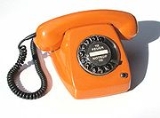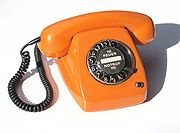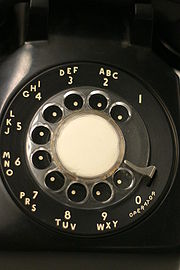
Rotary dial
Encyclopedia

Telephone
The telephone , colloquially referred to as a phone, is a telecommunications device that transmits and receives sounds, usually the human voice. Telephones are a point-to-point communication system whose most basic function is to allow two people separated by large distances to talk to each other...
or switchboard
Telephone switchboard
A switchboard was a device used to connect a group of telephones manually to one another or to an outside connection, within and between telephone exchanges or private branch exchanges . The user was typically known as an operator...
that is designed to send electrical pulses
Pulse (signal processing)
In signal processing, the term pulse has the following meanings:#A rapid, transient change in the amplitude of a signal from a baseline value to a higher or lower value, followed by a rapid return to the baseline value....
, known as pulse dialing
Pulse dialing
Pulse dialing, dial pulse, or loop disconnect dialing, also called rotary or decadic dialling in the United Kingdom , is pulsing in which a direct-current pulse train is produced by interrupting a steady signal according to a fixed or formatted code for each digit and at a standard pulse repetition...
, corresponding to the number dialed. The early form of the rotary dial used lugs on a finger plate instead of holes. Almon Brown Strowger filed the first patent for a rotary dial, U.S. patent#486,909, on December 21, 1891 that was later issued to him on November 29, 1892.
The modern version of the rotary dial with holes was first introduced in 1904 but did not enter service in the Bell System
Bell System
The Bell System was the American Bell Telephone Company and then, subsequently, AT&T led system which provided telephone services to much of the United States and Canada from 1877 to 1984, at various times as a monopoly. In 1984, the company was broken up into separate companies, by a U.S...
until 1919. The rotary dial was gradually supplanted by Dual-tone multi-frequency
Dual-tone multi-frequency
Dual-tone multi-frequency signaling is used for telecommunication signaling over analog telephone lines in the voice-frequency band between telephone handsets and other communications devices and the switching center. The version of DTMF that is used in push-button telephones for tone dialing is...
pushbutton dialing, introduced at the 1962 World's Fair
Century 21 Exposition
The Century 21 Exposition was a World's Fair held April 21, 1962, to October 21, 1962 in Seattle, Washington.Nearly 10 million people attended the fair...
, which uses a keypad
Telephone keypad
A telephone keypad is a keypad that appears on a "Touch Tone" telephone. It was standardised when the dual-tone multi-frequency system in the new push-button telephone was introduced in the 1960s, which gradually replaced the rotary dial....
instead of a dial. Some telephone systems in the US no longer recognize rotary dialing by default, but will only support push-button phone
Push-button telephone
The push-button telephone was first invented in 1941, and is a telephone with push-buttons or keys, and which eventually replaced rotary dial telephones that were first used in 1891. The first push-button telephone was invented in the labs of Bell Telephone; however, these models were only...
s.

History
From as early as 1836, there were various suggestions and inventions of dials for sending telegraphTelegraphy
Telegraphy is the long-distance transmission of messages via some form of signalling technology. Telegraphy requires messages to be converted to a code which is known to both sender and receiver...
signals. After the first commercial telephone exchange was installed in 1878, the need for an automated, user-controlled method of directing a telephone call became apparent. The rotary dial was invented by Almon Brown Strowger in 1891. There were numerous competing inventions, and 26 patents of dials, push-buttons, and similar mechanisms for signalling which telephone subscriber was wanted by a caller were issued prior to 1891. Most inventions involved costly, intricate mechanisms and required the user to perform complex manipulations.
The first commercial installation of a Telephone Dial accompanied the first commercial installation of a 99-line automatic telephone exchange in La Porte, Indiana in 1892, which was based on the 1891 Strowger-patent designs. The original dial designs were rather cumbersome and development continued during the 1890s and early 1900s hand in hand with the switching technology. In the 1950s, plastic dials supplanted metal ones in most new telephone designs.
Despite their obsolescence, rotary phones occasionally find special uses. For instance, the anti-drug Fairlawn Coalition of the Anacostia section of Washington, D.C. persuaded the phone company to reinstall rotary-dial pay phones in the 1980s to discourage loitering by drug purchasers, since the dials could not be used to call dealers' pagers.
General form


Telephone exchange names
During the early years of telephone service, communities that required more than 10,000 telephone numbers, whether dial service was available or not, utilized exchange names to distinguish identical numerics for different customers....
in communities having more than 9,999 telephone line
Telephone line
A telephone line or telephone circuit is a single-user circuit on a telephone communication system...
s, and additionally given a meaningful mnemonic
Mnemonic
A mnemonic , or mnemonic device, is any learning technique that aids memory. To improve long term memory, mnemonic systems are used to make memorization easier. Commonly encountered mnemonics are often verbal, such as a very short poem or a special word used to help a person remember something,...
to facilitate memorization of individual telephone number
Telephone number
A telephone number or phone number is a sequence of digits used to call from one telephone line to another in a public switched telephone network. When telephone numbers were invented, they were short — as few as one, two or three digits — and were given orally to a switchboard operator...
s by incorporating their exchange names. For example: "RE7-xxxx" represented "REgent 7-xxxx", 'Regent' being a local exchange name used in Canada, derived from an earlier precursor telephone number, '7xxxx' –with callers actually dialing '73-7xxxx' (737-xxxx).
In the United Kingdom the letter "O" was combined with the digit "0" rather than "6". Older Australian rotary dial telephones also had letters, but the combinations were often printed in the center plate adjacent to the number. The Australian letter to number mapping was: A=1, B=2, F=3, J=4, L=5, M=6, U=7, W=8, X=9, Y=0, so the phone number BX 3701 was in fact 29 3701. However, such letter codes were not used in all countries. The 1 is normally set at approximately 60 degrees clockwise from the uppermost point of the dial, or approximately at the 2 o'clock position, and then the numbers progress counterclockwise, with the 0 being at about 5 o'clock. A curved device called a finger stop sits above the dial at approximately the 4 o'clock position.
Dials outside Canada, the United States, and large cities in Britain (before all-figure dialing
All figure dialling
All-figure dialling refers to the change in the UK telephone numbering plan in 1966when the three-digit numbers for local telephone exchanges in director areas began to be assigned without reference to any correspondence to the letters on the telephone dial...
) usually did not bear alphabetic characters or an indication of the word "operator" in addition to numbers. Alphabetic designation of exchanges was also used for a short period in the Soviet Union in the 1950s, but by the next decade this practice was largely discontinued.
The physical nature of the dialing mechanism on rotary phones allowed the use of physical locking mechanisms to prevent unauthorized use. The lock could be integral to the phone itself or a separate device inserted through the finger hole nearest the finger stop to prevent the dial rotating.
Function
To dial a number, the user puts a finger in the corresponding finger hole and rotates the dial clockwise until it reaches the finger stop. The user then pulls out the finger, and a spring in the dial returns it to the resting position. For example, if the user dials "6" on a North American phone, electrical contacts wired through the camCam
A cam is a rotating or sliding piece in a mechanical linkage used especially in transforming rotary motion into linear motion or vice-versa. It is often a part of a rotating wheel or shaft that strikes a lever at one or more points on its circular path...
mechanism inside the phone will open and close six times as the dial returns to home position, thus sending six pulses to the central office.
Different pulse systems are used, varying from country to country. For example, Sweden uses one pulse to signal the number zero, and 10 pulses to signal the number nine. New Zealand uses ten pulses minus the number desired; so dialling 7 produces three pulses. In Norway, the North American system with the number 1 corresponding to one pulse was used, except from the capital, Oslo
Oslo
Oslo is a municipality, as well as the capital and most populous city in Norway. As a municipality , it was established on 1 January 1838. Founded around 1048 by King Harald III of Norway, the city was largely destroyed by fire in 1624. The city was moved under the reign of Denmark–Norway's King...
, which used the same "inverse" system as in New Zealand. For this reason, the numbers on the dial are shifted in different countries, or even in different areas of one country, to work with their system because of the difference of the number arrangement on the dial. The dial numbering can occur in 4 different formats, with 0 adjacent either to the 1 or the 9 and the numbers running in ascending or descending order with either the 0,1 or 9 being closest to the fingerstop.
A relic of these differences is found in emergency telephone number
Emergency telephone number
Many countries' public telephone networks have a single emergency telephone number, sometimes known as the universal emergency telephone number or occasionally the emergency services number, that allows a caller to contact local emergency services for assistance. The emergency telephone number may...
s used in various countries; the United Kingdom selected 999
999 (emergency telephone number)
999 is an official emergency telephone number in a number of countries which allows the caller to contact emergency services for urgent assistance....
due to the ease of converting call office dials to make free calls ('0' for the Operator was already free), whereas in New Zealand's 111
1-1-1
111 is the emergency telephone number in New Zealand. It was first implemented in Masterton and Carterton on 29 September 1958, and was progressively rolled out nationwide with the last exchanges converting in 1988...
was selected for the same reason: 111 actually pulses 999 to the central office/telephone exchange.
Early dials worked by direct or forward action. The pulses went out as the dial went around to the finger stop. When the user's hand motion was not smooth, it produced wrong numbers. In the late 19th century the dial was refined to be operated by a recoil spring and centrifugal governor
Centrifugal governor
A centrifugal governor is a specific type of governor that controls the speed of an engine by regulating the amount of fuel admitted, so as to maintain a near constant speed whatever the load or fuel supply conditions...
. The user selects the digit to be dialed, rotates the dial to the finger stop, then releases it. The spring causes the dial to return to its home position and the governor regulates the dialing pulses at its design rate, usually approximately 10 per second, and sometimes as many as 20 pulses per second. The rotary dial governor is subject to wear and aging, and may require periodic cleaning, lubrication and adjustment by a telephone technician.

Western Electric
Western Electric Company was an American electrical engineering company, the manufacturing arm of AT&T from 1881 to 1995. It was the scene of a number of technological innovations and also some seminal developments in industrial management...
on the compact Trimline telephone
Trimline telephone
The Western Electric Trimline telephone is a variety of telephone set designed by Donald Genaro of Henry Dreyfuss Associates for the Bell System . It was built by the Bell System's manufacturing arm, Western Electric. The idea behind the Trimline telephone was to create an alternative telephone...
, the first to locate the dial in the handset.
Rotary dial telephones in the United States were sometimes equipped with a blankoff plate in place of a dial. In the Bell System, these telephones were referred to as non-dial. The most common applications for non-dial telephones were on Automatic ringdown circuits
Ringdown
-Operator signaling:In telephony, ringdown is a method of signaling an operator in which telephone ringing current is sent over the line to operate a lamp or cause the operation of a self-locking relay known as a drop...
or manual service.
Rotary dial telephones in Australia were sometimes equipped, in later years, with touch pad blanks, designed to look like a touch-phone, but providing the rotary dial signalling required by the Australian phone system.
Rotary dial telephones have no redial feature; the complete number has to be dialed for every attempted call. Users could employ pencils or other tools for dialing to avoid finger strain.
See also
- Crossbar switchCrossbar switchIn electronics, a crossbar switch is a switch connecting multiple inputs to multiple outputs in a matrix manner....
- Stepping switchStepping switchIn electrical controls, a stepping switch, also known as a stepping relay, is an electromechanical device which allows an input connection to be connected to one of a number of possible output connections, under the control of a series of electrical pulses. It can step on one axis , or on two axes...
- Dual-tone multi-frequencyDual-tone multi-frequencyDual-tone multi-frequency signaling is used for telecommunication signaling over analog telephone lines in the voice-frequency band between telephone handsets and other communications devices and the switching center. The version of DTMF that is used in push-button telephones for tone dialing is...
(DTMF, also called Touch Tone) - Pulse dialingPulse dialingPulse dialing, dial pulse, or loop disconnect dialing, also called rotary or decadic dialling in the United Kingdom , is pulsing in which a direct-current pulse train is produced by interrupting a steady signal according to a fixed or formatted code for each digit and at a standard pulse repetition...
or decadic dialing. - Dial toneDial toneA dial tone is a telephony signal used to indicate that the telephone exchange is working, has recognized an off-hook, and is ready to accept a call. The tone stops when the first numeral is dialed...
- TelephoneTelephoneThe telephone , colloquially referred to as a phone, is a telecommunications device that transmits and receives sounds, usually the human voice. Telephones are a point-to-point communication system whose most basic function is to allow two people separated by large distances to talk to each other...
- Push-button telephonePush-button telephoneThe push-button telephone was first invented in 1941, and is a telephone with push-buttons or keys, and which eventually replaced rotary dial telephones that were first used in 1891. The first push-button telephone was invented in the labs of Bell Telephone; however, these models were only...
- Off-hookOff-hookIn telephony, the term off-hook has the following meanings:# The condition that exists when a telephone or other user instrument is in use, i.e., during dialing or communicating. Note: off-hook originally referred to the condition that prevailed when telephones had a separate earpiece , which hung...
- Telephone exchangeTelephone exchangeIn the field of telecommunications, a telephone exchange or telephone switch is a system of electronic components that connects telephone calls...
- Single-frequency signalingSingle-frequency signalingSingle-frequency signaling is line signaling in which dial pulses or supervisory signals are conveyed by a single voice-frequency tone in each direction...
- RingdownRingdown-Operator signaling:In telephony, ringdown is a method of signaling an operator in which telephone ringing current is sent over the line to operate a lamp or cause the operation of a self-locking relay known as a drop...
- Ringing signal
- Ericsson DialogEricsson DialogEricsson Dialog is a Swedish telephone model by Ericsson, released 1964. Millions of the model were sold and it retained its place in homes well into the 1990s...
Services
- Direct Distance Dialing (DDD)Direct distance dialingDirect distance dialing or direct dial is a telecommunications term for a network-provided service feature in which a call originator may, without operator assistance, call any other user outside the local calling area. DDD requires more digits in the number dialed than are required for calling...
- HotlineHotlineIn telecommunication, a hotline is a point-to-point communications link in which a call is automatically directed to the preselected destination without any additional action by the user when the end instrument goes off-hook...
- Automatic identified outward dialing (AIODAIOD leadsAIOD leads are Terminal equipment leads used solely to transmit automatic identified outward dialing data from a PBX to the public switched telephone network or to switched service networks , so that a vendor can provide a detailed monthly bill identifying long distance calling usage by...
)
External links
- Spring 1957 Issue of The Kansas Historical Quarterly
- "How Your Dial Phone Works", August 1946, Popular Science detailed article on subject with illustrations
- Adding a On/Off Switch to the Ringer of a Rotary Phone

